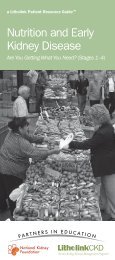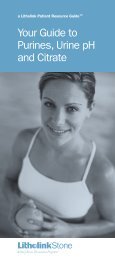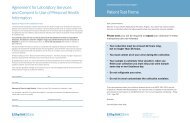Your Guide to a Low Oxalate Diet - Litholink
Your Guide to a Low Oxalate Diet - Litholink
Your Guide to a Low Oxalate Diet - Litholink
You also want an ePaper? Increase the reach of your titles
YUMPU automatically turns print PDFs into web optimized ePapers that Google loves.
a <strong>Litholink</strong> Patient Resource <strong>Guide</strong> <br />
<strong>Your</strong> <strong>Guide</strong> <strong>to</strong><br />
a <strong>Low</strong> <strong>Oxalate</strong> <strong>Diet</strong>
In this brochure you will find<br />
common questions asked about<br />
oxalate and kidney s<strong>to</strong>ne<br />
prevention, and the answers <strong>to</strong><br />
each of them.<br />
1<br />
2<br />
<strong>Your</strong> <strong>Guide</strong> <strong>to</strong> a <strong>Low</strong> <strong>Oxalate</strong> <strong>Diet</strong><br />
“ What is oxalate?”<br />
Most oxalate is a waste product made by the body and<br />
has no function in humans. The most common type of<br />
kidney s<strong>to</strong>ne (80%) is made of calcium and oxalate.<br />
Other sources of oxalate include:<br />
• Eating foods high in oxalate<br />
• Intestinal over absorption (patients who have had<br />
intestinal resections due <strong>to</strong> inflamma<strong>to</strong>ry bowel<br />
disease or gastric bypass surgery)<br />
• Excess amounts of vitamin C (2,000 mg or more per<br />
day; the excess converts <strong>to</strong> oxalate)<br />
• Abnormalities of metabolism<br />
“ My urologist <strong>to</strong>ld me <strong>to</strong> cut back on<br />
oxalate. My cardiologist <strong>to</strong>ld me <strong>to</strong><br />
eat plenty of vegetables and cut back<br />
on fats. What am I supposed <strong>to</strong> do?”<br />
It can be challenging when you have doc<strong>to</strong>rs telling<br />
you different things. One doc<strong>to</strong>r is worried about your<br />
heart (diabetes, hypertension, etc), the other about your<br />
kidney s<strong>to</strong>nes. You must remember that as with any<br />
lifestyle change you should cut back in moderation.<br />
It is not reasonable <strong>to</strong> cut out fruits and vegetables<br />
from your diet, as they provide so many important<br />
nutrients. Many fruits and vegetables have low<br />
oxalate content and can be regularly included in your<br />
diet (see list included in this brochure).<br />
If you are going <strong>to</strong> have a high oxalate food, such as a spinach<br />
salad, just limit the amount of spinach you are having.<br />
Also, remember <strong>to</strong> flush out the extra oxalate you are<br />
eating with a glass of water before and after your meal.
“ When I go on the internet <strong>to</strong> look up<br />
oxalate content of certain foods, I<br />
find different sites list different numbers<br />
for the same food. Why is this?”<br />
<strong>Oxalate</strong> content of a single food group varies based on<br />
the time of year, the type of soil it is grown in and a<br />
host of other fac<strong>to</strong>rs specific <strong>to</strong> the growing conditions<br />
of the plant which are seldom accounted for in this<br />
type of research.<br />
3 5<br />
4<br />
“ What effect does bowel disease and/<br />
or intestinal surgeries with malabsorption<br />
have on my oxalate levels?”<br />
There is a definite correlation between patients who<br />
suffer from bowel disease and malabsorption problems<br />
and the formation of kidney s<strong>to</strong>nes. Their urine is<br />
more acidic, citrate levels are lower, and oxalate levels<br />
are much higher. If you have had an ileal resection<br />
you may experience an increase in your oxalate levels<br />
due <strong>to</strong> malabsorption problems.<br />
In bowel disease, fatty acids and bile that are normally<br />
absorbed by the small intestine reach the colon.<br />
When fatty acids and bile reach the colon, they can<br />
damage the colon lining allowing oxalate <strong>to</strong> pass<br />
through the damaged lining in<strong>to</strong> the blood, and then<br />
in<strong>to</strong> the urine via the kidneys. When calcium and<br />
oxalate are <strong>to</strong>gether in the kidney, they can bind <strong>to</strong>gether<br />
<strong>to</strong> form crystals. These crystals can join <strong>to</strong>gether<br />
<strong>to</strong> form calcium oxalate kidney s<strong>to</strong>nes.<br />
6<br />
“My doc<strong>to</strong>r said that limiting my fat<br />
intake will also help lower my oxalate<br />
level. How is this?”<br />
For patients who suffer from small bowel disease or<br />
malabsorption, it is recommended that dietary fat<br />
intake be controlled. Excess fat will bind with<br />
calcium in food, thus leaving oxalate by itself <strong>to</strong> be<br />
reabsorbed by the colon and back in<strong>to</strong> the blood<br />
stream. If <strong>to</strong>o much oxalate is absorbed, it will<br />
combine with calcium in the kidney and can lead <strong>to</strong><br />
calcium oxalate s<strong>to</strong>nes.<br />
<strong>Your</strong> doc<strong>to</strong>r may also prescribe a drug called<br />
Cholestyramine. This is a drug taken at each meal<br />
that binds fatty acids, bile and oxalate so all three<br />
can leave the body.<br />
“ My doc<strong>to</strong>r said I am making calcium<br />
oxalate s<strong>to</strong>nes. Should I cut back on<br />
dairy products <strong>to</strong>o?”<br />
Unless <strong>to</strong>ld otherwise by your doc<strong>to</strong>r, your diet should<br />
have between 800 and 1,200 mg of calcium per day.<br />
Eating a diet low in calcium is not advised. In fact,<br />
studies have shown that eating low calcium diets will<br />
increase calcium oxalate s<strong>to</strong>ne risk.<br />
<strong>Oxalate</strong> and calcium bind <strong>to</strong>gether in your intestine<br />
and leave the body <strong>to</strong>gether. If you eat a low calcium<br />
diet then oxalate has no partner <strong>to</strong> leave the body<br />
with. <strong>Oxalate</strong> will then be absorbed back in<strong>to</strong> your<br />
system leading <strong>to</strong> higher oxalate levels in your body.
7<br />
“ I am lac<strong>to</strong>se in<strong>to</strong>lerant. What can I<br />
do <strong>to</strong> increase my dietary calcium?”<br />
Being lac<strong>to</strong>se in<strong>to</strong>lerant is a common problem. You<br />
can get calcium from other sources other than dairy<br />
products.<br />
Cereals and orange juice are now fortified with calcium<br />
(see below list). <strong>Your</strong> doc<strong>to</strong>r may also tell you <strong>to</strong> take<br />
calcium supplements with each meal <strong>to</strong> help bind<br />
with oxalate so it cannot be reabsorbed back in<strong>to</strong> your<br />
bloodstream.<br />
Non-dairy calcium rich foods<br />
Foods containing 50 mg of calcium:<br />
Bread 2 slices<br />
Broccoli 3⁄4 cup<br />
Kidney beans, lima beans, lentils 1 cup<br />
Orange medium<br />
Tahini 2 tbsp<br />
Foods containing 75 mg of calcium:<br />
Bok choy or kale, cooked 1⁄2 cup<br />
Chickpeas 1 cup<br />
Almonds 1⁄4 cup<br />
Foods containing 250 mg of calcium:<br />
Salmon, canned with bones 1⁄2 can<br />
Sardines, canned with bones 1⁄2 can<br />
8<br />
“ Because I am lac<strong>to</strong>se in<strong>to</strong>lerant I eat<br />
a lot of soy products. I heard that<br />
soy is high in oxalate.”<br />
Recent research has concluded that the soy products<br />
listed below do have high levels of oxalate and should<br />
be eaten in moderation.<br />
Serving <strong>Oxalate</strong><br />
Size Content<br />
(ounce) (mg/serving)<br />
Textured vegetable protein 3 496<br />
Soy nuts 1 392<br />
Soy beverage 8.5 336<br />
Tofu with calcium 3 235<br />
Soy yogurt 8.5 113<br />
Tofu with magnesium 3 94<br />
Soy burger 2.5 58<br />
Tempeh 3 23<br />
Soy cheese 1 16<br />
Source: “<strong>Oxalate</strong> Content of Soybean Seeds, Soy foods, and other<br />
Edible Legumes”, LK Massey, Palmer RG, Horner, HT. Journal<br />
of Agricultural and Food Chemistry, September 2001.
Facts<br />
• <strong>Oxalate</strong> is made in plants, animals and humans;<br />
highest amounts appear in certain plant foods.<br />
• The function of oxalate is <strong>to</strong> help plants dispose<br />
of excess calcium.<br />
• Our bodies have no use for oxalate and it is<br />
excreted in the urine.<br />
• Our bodies always have some varying degree<br />
of oxalate.<br />
• About 40-50% of oxalate is from outside sources<br />
(foods you eat) and can be much higher on a high<br />
oxalate diet.<br />
Items listed below contain high levels of oxalate. Items<br />
are reported by the milligram of oxalate/100 gm (100<br />
grams is approximately 3.5 ounces). Foods that have<br />
less than 50 mg of oxalate per serving should be limited<br />
<strong>to</strong> 4 oz per day. Foods higher than 50 mg of oxalate per<br />
serving should be strictly limited. If you do eat something<br />
that has a very high oxalate content, make sure<br />
you drink a glass of water before and after the product<br />
<strong>to</strong> help flush out the extra oxalate.<br />
mg of<br />
<strong>Oxalate</strong><br />
Cereals and Cereal Products /100g<br />
Bran Flakes ............................................. 141.0<br />
Cake, fruit ................................................. 11.8<br />
Cake, sponge ............................................... 7.4<br />
Crackers, soybean ................................... 207.0<br />
Fiber One ............................................... 142.0<br />
Grits ..... .................................................... 41.0<br />
Wheat Germ .......................................... 269.0<br />
White bread .............................................. 14.3<br />
Meats<br />
Liver ........................................................... 7.1<br />
Fruits<br />
Berries, black ............................................ 18.0<br />
Berries, blue .............................................. 15.0<br />
Berries, Green Goose ................................ 88.0<br />
Berries, raspberries black ........................... 53.0<br />
Berries, raspberries red .............................. 15.0<br />
Berries, strawberries, can .......................... 15.0<br />
Berries, strawberries raw ........................... 10.0<br />
Currants, red ............................................. 19.0<br />
Fruit salad, can .......................................... 12.0<br />
Grapes, concord ........................................ 25.0<br />
Lemon peel .............................................. 83.0<br />
Lime peel .............................................. 110.00<br />
Peaches, Albert ........................................... 5.0<br />
Plums, Damson ........................................ 10.0<br />
Preserves, strawberry jam ............................ 9.4<br />
Prunes, Italian ............................................. 5.8<br />
Rhubarb, can ......................................... 600.00<br />
Rhubarb, stewed, no sugar .................... 800.00
Vegetables<br />
Asparagus ................................................... 5.2<br />
Beans, green boiled ................................... 15.0<br />
Beetroot, boiled....................................... 675.0<br />
Celery ....................................................... 20.0<br />
Chard, swiss ............................................ 645.0<br />
Collards .................................................... 74.0<br />
Corn, yellow ................................................ 5.2<br />
Dandelion greens ...................................... 24.6<br />
Eggplant ................................................... 18.0<br />
Escarole .................................................... 31.0<br />
Kale .......................................................... 13.0<br />
Leek .......................................................... 89.0<br />
Mustard greens ........................................... 7.7<br />
Okra ....................................................... 146.0<br />
Parsley, raw ............................................. 100.0<br />
Parsnips .................................................... 10.0<br />
Pepper, green ............................................. 16.0<br />
Pota<strong>to</strong>es, sweet .......................................... 56.0<br />
Rutabagas ................................................. 19.0<br />
Spinach ................................................... 600.0<br />
Squash, summer ........................................ 22.0<br />
Watercress ................................................. 10.0<br />
Nuts<br />
Peanuts, roasted ...................................... 187.0<br />
Peanut butter ............................................ 95.8<br />
Pecans ....................................................... 22.0<br />
Confections<br />
Chocolate ............................................... 117.0<br />
Butterfinger (candy bar) ............................ 53.5<br />
Marmalade................................................ 10.8<br />
Beverages<br />
Tea, Indian; 2 min infusion ....................... 55.0<br />
Tea, Indian; 4 min infusion ....................... 72.0<br />
Tea, Indian; 6 min infusion ....................... 78.0<br />
Juices<br />
Cranberry juice ........................................... 6.6<br />
Grape juice.................................................. 5.8<br />
Toma<strong>to</strong> juice ............................................... 5.5<br />
Miscellaneous<br />
Cocoa, dry powder .................................. 623.0<br />
Coffee instant (Nescafe) ........................... 33.0<br />
Ovaltine, powder can ................................ 35.0<br />
Pepper, black ........................................... 419.0<br />
Vegetable soup ............................................ 5.0<br />
© 2005 <strong>Litholink</strong> Corporation (Physician and patients may copy for<br />
non commercial purposes without obtaining permission.)
If you have any questions, please call<br />
us at (800) 338 4333, and ask <strong>to</strong> speak<br />
<strong>to</strong> a Patient Care Representative.<br />
Our hours of operation are Monday – Friday,<br />
7:30am – 6:00pm Central Standard Time.<br />
You may also visit our website at<br />
www.litholink.com and send any<br />
e-mail inquiries <strong>to</strong> info@litholink.com.<br />
<strong>Litholink</strong> Corporation<br />
2250 West Campbell Park Drive<br />
Chicago, Illinois 60612<br />
800 338 4333 Telephone<br />
312 243 3297 Facsimile<br />
www.litholink.com V2/LLK0041








